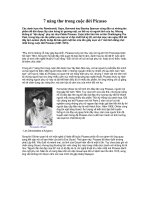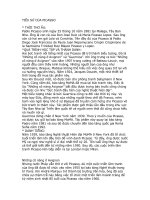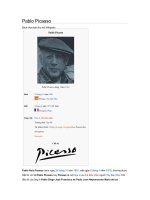pablo picasso 1087
Bạn đang xem bản rút gọn của tài liệu. Xem và tải ngay bản đầy đủ của tài liệu tại đây (39.02 KB, 2 trang )
Pablo, Picasso (a Spanish painter) who is widely acknowledged to be the most important artist of
the 20th century was born Pablo Ruiz in Malaga, Spain and later adopted his mother's unique
name
Picasso. Though Picasso was born in Spain he spent most of his life in France. As a child Pablo
was a prodigy. He studied art first privately with his father and then at the Academy of Fine Arts
in La Coruna, Spain, where his father taught. Picasso's early drawings, such as Study of a Torso,
After a Plaster Cast (1894-1895), and Musee demonstrate the high level of technical talent he had
achieved by the age of 14.Picasso was admitted to advanced classes at the academy after he
completed in a single day the entrance examination that applicants traditionally were given a
month to finish. In 1897 Picasso left Barcelona to study at the Madrid Academy in the Spanish
capital. Dissatisfied with the training, he quit and returned to Barcelona.
Later in 1904 Picasso settled in France where he encountered and experimented with, a number of
modern artistic styles. Picasso's painting Le Moulin de la Galette (1900, Guggenheim Museum,
New York City) revealed his interest in the subject matter of Parisian nightlife.In addition to café
scenes, Picasso painted landscapes, still lifes, and portraits of friends and performers.From 1901
to 1903 Picasso initiated his first truly original style, which is known as the blue period.
Restricting his color scheme to blue, Picasso depicted wasted and pitiful figures whose body
language and clothing showed the humbleness of their social status. In The Old Guitarist (1903,
Art Institute of Chicago, Illinois), Picasso
the guitarist's poverty and position as a social outcast, which he by surrounding the figure with a
black outline, as if to cut him off from his environment. The guitarist is compressed within the
canvas (no room is left in the painting for the guitarist to raise his lowered head), suggesting his
helplessness: The guitarist is trapped within the frame just as he is trapped by his poverty.
Although Picasso underscored the unpleasantness of his figures during this period, neither their
clothing nor their environment shows a specific time or place. This lack of specificity suggests that
Picasso intended to make a general statement about human alienation (isolation)rather than a
particular statement about the lower class in Paris.
The year 1912 marks another major development in the cubist language: the invention of collage.
In Still Life with Chair Caning (1912, Musee Picasso), Picasso attached a piece of oilcloth (that
depicts woven caning) to his work. With this action Picasso not only violated the truthfulness of
the medium oil painting on canvas but also included a material that had no previous connection
with high art. Art could now be created (Picasso seems to imply,) with scissors and glue as well as
with paint and canvas. By including pieces of cloth, newspaper, wallpaper, and other materials in
his work, Picasso opened the door for any object or material, to be included in (or even replace) a
work of art. This improvement had an important cost for later 20th century art. Another innovation
(or improvement) was including the letters JOU in the painting, possibly referring to the beginning
of the word journal (French for "newspaper") or to the French word jouer, meaning "to play," as
Picasso is playing with forms. These combinations reveal that cubism includes both visual and
verbal references, and merges high art with popular culture.In 1937 the Spanish government
commissioned Picasso to create a mural for Spain's pavilion at an international exposition in Paris.
Unsure about the subject, Picasso procrastinated. But he set to work almost immediately after
hearing that the Spanish town of Guernica had been bombed by Nazi warplanes in support of
Spanish general Francisco Franco's plot to overthrow the Spanish republic. Guernica (1937,
Prado, Madrid) was Picasso's response to, and condemnation of, that event. He executed the
painting in black and white in keeping with the seriousness of the subject and transfigured the
event according to his fascination with the bullfight theme.
At the extreme left is a bull, which symbolizes brutality and darkness, according to Picasso. At the
center, a horse wounded by a spear most likely represents the Spanish people. At the center on
top, an exploding light bulb possibly refers to air warfare or to evil coming from above (and
putting out the light of reason). Corpses and dying figures fill the foreground: a woman with a
dead child at the left, a dead warrior with a broken sword (from which a flower sprouts) at the
center, a weeping woman and a figure falling through a burning building at the right. The
distortion of these figures expresses the inhumanity of the event. To suggest the screaming of the
horse and of the mother with the dead child, Picasso transformed their tongues into daggers. In the
upper center, a tormented female figure holds an oil lamp that sheds light upon the scene, possibly
symbolizing the light of truth revealing the brutality of the event to the outside world. In 1936
Picasso met Dora Maar, an artist who photographed Guernica as he painted it. She soon became
his companion and the subject of his paintings, although he remained involved with Walter.
Picasso's emotional life became more complicated after he met French painter Françoise Gilot in
the 1940s, while he was still involved with Maar. He and Gilot had a son, Claude, and a daughter,
Paloma, and both appear in many of his late works. Picasso and Gilot parted in 1953. Jacqueline
Roque, whom Picasso married in 1961, became his next companion. They spent most of their time
in the south of France.
One of Picasso's late works, Head of a Woman (1967), was a gift to the city of Chicago. This
sculpture of welded steel, 15 m (50 ft) tall, stands in front of Chicago's Civic Center. and the
sculpture soon became a city landmark.
Because of his many innovations, Picasso is widely considered to be the most influential artist of
the 20th century. The cubist movement, which he and Braque inspired, had a number of followers.
Its innovations gave rise to a host of other 20th-century art movements.
While still a medical student, Williams founded Provident Hospital in 1891 to provide greater
opportunities for black medical professionals. Provident was the first Chicago hospital to admit
blacks to its staff, and the first racially integrated hospital in the city. It included the first nursing
school for black women in the United States.









